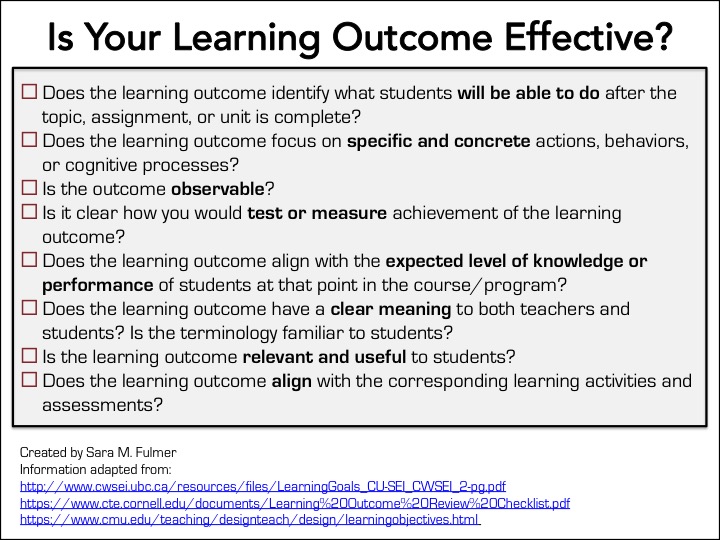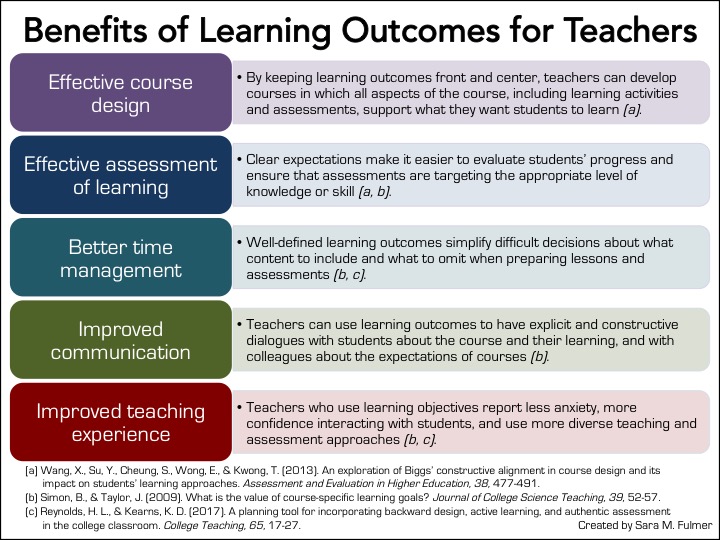GUEST POST: Should I share my learning outcomes with students?
Dr. Sara M. Fulmer is an Educational Developer at the University of Guelph. She supports faculty, graduate students, and academic programs with implementing evidence-based approaches to enhance pedagogical practices and students’ learning. Her areas of research include student motivation in challenging contexts and teacher professional development. She received her B.A., B.Ed., and M.A. from Brock University in Ontario, Canada, and Ph.D. in Developmental Psychology from the University of Notre Dame. You can find her on Twitter @sara_fulmer. Sara previously contributed guest posts on learner-centered syllabi and how manipulatives can hinder learning.
How do you know which path to choose, or whether you have arrived, if you do not have a destination? In the context of teaching and learning, learning outcomes are the destination.
Image from Wikimedia
This post responds to a reader’s question, “Is there any evidence to support sharing written learning outcomes prior to teaching a topic?”
By the end of reading this blog post, readers should be able to:
- Evaluate the effectiveness of a learning outcome using a checklist
- Describe the benefits of learning outcomes for students and teachers
- Identify strategies to share learning outcomes with students
What are learning outcomes?
"Learning outcomes are measurable statements that articulate what students should know, be able to do, or value as a result of taking a course or completing a program" (1). In addition to a course or program, we can also write learning outcomes for smaller elements of the learning process, such as an assignment, single class session, or unit. Effective learning outcomes are student-centered, specific, and measurable, and provide a road map for determining the content, organization, and assessment of the course.
To learn more about writing effective learning outcomes, see this post on setting learning outcomes and this resource on the differences between learning goals, learning objectives, and learning outcomes.
Why share learning outcomes with students?
Learning outcomes can increase student learning in foundational knowledge or short-term retention (2), (3) and higher-order cognitive processes, such as application or transfer (3), (4), (5). For example, student exam performance increased after a faculty member redesigned an introductory biology course by creating learning goals for each class session, making these goals explicit to students in each lecture, and labeling exam questions with the corresponding learning goal (4). These students also rated learning goals as the most helpful component of lecture, beating out clicker questions, quizzes, vocabulary lists, and group work (4).
But why do learning outcomes improve learning? Learning outcomes shape what students learn. When students know what they are expected to learn, they can direct their attention towards those particular areas (6) and use deliberate practice to strategically work towards learning those concepts and skills. Students in courses with clear learning outcomes aligned with the assessments, compared to students in courses without these components, are more likely to spend extra time studying and extend their knowledge by seeking additional information (7). Stating learning outcomes at the start of a lesson, unit, or course is also an important element of guided instruction, which is more beneficial than less-structured approaches for learning, particularly for novice learners.
Image from Pixabay
Knowing the learning outcomes in advance also helps students practice metacognition and become self-regulated learners (3), (8), (9). For example, undergraduate students report that having clear learning outcomes helps them to narrow their focus on important concepts and skills, organize their notes, track their learning towards those outcomes, and improve their study practices (10). Because learning outcomes help students to make strategic decisions, students also feel an increased sense of control or ownership over their learning (1), (9).
Sharing learning outcomes prior to learning can also increase students’ motivation and engagement (2), (4), (11). Learning outcomes give learners a sense of purpose for their learning, answering the frequently asked question, “Why am I learning this?” Learning outcomes help students feel more connected to the course material and perceive the content as useful (8), (10). When students understand what is expected of their learning, they are more likely to feel that they can be successful in meeting those expectations. For example, students who receive assignments with a clear purpose and explicit connection to course learning outcomes report greater academic confidence and a feeling of mastery of important skills (2). This is particularly true for first-generation, low-income, and underrepresented students (2). One reason why students feel more confident is because learning outcomes reduce ambiguity in a course. This is exemplified in a quote from an undergraduate student in Wang et al.’s (7) study:
“They (The instructors) are supposed to spell out what I shall achieve so that I do not have to guess. I know what they intend to teach, but I am not very clear what kind of outcomes they want us to achieve. For example, to what level are we going to apply the knowledge we have learnt.”
Worried about learning outcomes limiting students’ creativity? Check out this post on ways to use learning outcomes to set high standards and foster creativity and innovation.
Having clear learning outcomes also benefits teachers. The following table summarizes the literature on these benefits.
How can I share learning outcomes with students?
Learning outcomes can appear anywhere, such as a slide, whiteboard, handout, classroom poster, or in your learner-centered course syllabus. For creative ideas, check out these strategies for higher education, and for K-12, 40 ways to introduce learning objectives and this teacher’s decision-making process regarding how to share learning outcomes in his class.
The most important step of sharing learning outcomes is to ensure that students understand the learning outcomes. Engage students in a discussion about the learning outcomes with questions like:
- Using your own words, what does this outcome mean?
- How will I know if I’ve achieved this outcome?
- Why do you think it’s important that we learn this?
- How does this learning outcome relate to something we’ve already learned?
Bonus: these questions also help to stimulate students’ interest and curiosity!
At the end of the topic or unit, ask students to write on an index card or sticky note an answer to: “What do you think you were supposed to learn from this lesson/class/unit?” (9).
You can also introduce students to learning outcomes through a pre-assessment, asking students to rate their level of confidence or level of current knowledge/skill for each of the learning outcomes. The image below offers some examples of how learning outcomes were transformed into survey items.
This strategy offers several added bonuses:
- Gathering information about students’ current level of knowledge before you begin teaching a unit will help you adjust your instruction to meet students where they are.
- Students have an opportunity to think about their current knowledge with respect to each of the learning outcomes, while gaining insight into what they will be expected to know and be able to do.
- You can track changes in students’ perceptions of their knowledge over time. Give students the same survey before and after the unit/course and compare their “pre” and “post” responses. Share the aggregated data with students to help them recognize how much they have learned.
How will you share learning outcomes with your students? Comment below!
References:
(1) Cornell University Center for Teaching Innovation. Setting Learning Outcomes.
https://www.cte.cornell.edu/teaching-ideas/designing-your-course/settting-learning-outcomes.html
(2) Winkelmes, M.-A., Bernacki, M., Butler, J., Zochowski, M., Golanics, J., & Weavil, K. H. (2016). A teaching intervention that increases underserved college students’ success. Peer Review, 18. http://www.aacu.org/peerreview/2016/winter-spring/Winkelmes
(3) Levine, L. E., Fallahi, C. R., Nicoll-Senft, J. M., Tessier, J. T., Watson, C. L., & Wood, R. M. (2008). Creating significant learning experiences across disciplines. College Teaching, 56, 247-254. http://www.tandfonline.com/doi/abs/10.3200/CTCH.56.4.247-254
(4) Armbruster, P., Patel, M., Johnson, E., & Weiss, M. (2009). Active learning and student-centered pedagogy improve student attitudes and performance in introductory biology. CBE Life Sciences Education, 8, 203-213. https://www.ncbi.nlm.nih.gov/pmc/articles/PMC2736024/
(5) Rust, C., Price, M, & O’Donovan, B. (2003). Improving students’ learning by developing their understanding of assessment criteria and processes. Assessment & Evaluation in Higher Education, 28, 147-164. http://area.fc.ul.pt/artigos%20publicados%20internacionais/Improving%20students%20learning.pdf
(6) Rothkopf, E. Z., & Billington, M. J. (1979). Goal-guided learning from text: Inferring a descriptive processing model from inspection times and eye movements. Journal of Educational Psychology, 71, 310-327.
(7) Wang, X., Su, Y., Cheung, S., Wong, E., & Kwong, T. (2013). An exploration of Biggs’ constructive alignment in course design and its impact on students’ learning approaches. Assessment & Evaluation in Higher Education, 38, 477-491. http://www.tandfonline.com/doi/abs/10.1080/02602938.2012.658018
(8) Reed, D. (2012). Clearly communicating the learning objective matters! Middle School Journal, 43, 16-24. http://www.tandfonline.com/doi/abs/10.1080/00940771.2012.11461825
(9) Fletcher-Wood, H. (2013, October 6). How I’ve tried to share learning intentions better. A Guide to Improving Teaching Blog. https://improvingteaching.co.uk/2013/10/06/how-ive-tried-to-share-learning-intentions-better/
(10) Simon, B., & Taylor, J. (2009). What is the value of course-specific learning goals? Journal of College Science Teaching, 39, 52-57. http://www.cwsei.ubc.ca/SEI_research/files/LifeSci/Simon_Taylor_ValueOfCourseSpecificLG.pdf
(11) Reynolds, H. L., & Kearns, K. D. (2017). A planning tool for incorporating backward design, active learning, and authentic assessment in the college classroom. College Teaching, 65, 17-27. http://www.tandfonline.com/doi/abs/10.1080/87567555.2016.1222575









